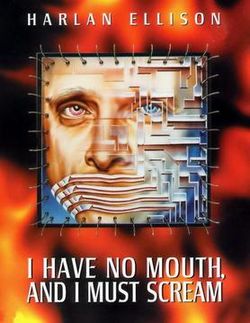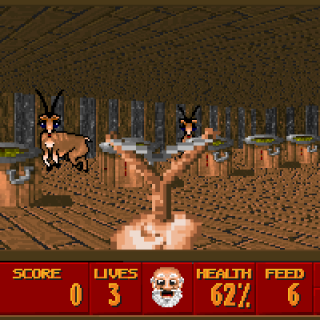 Released in 1995, just as the adventure game genre was falling off a cliff, I Have No Mouth Et Cetera captures the industry in its final nihilistic burn-it-to-the-ground moment, where game developers were flailing around and trying every crazy idea to win back their audience from Myst. A lot of fascinating experiments emerged from this period, including this adaptation of a Harlan Ellison short story.
Released in 1995, just as the adventure game genre was falling off a cliff, I Have No Mouth Et Cetera captures the industry in its final nihilistic burn-it-to-the-ground moment, where game developers were flailing around and trying every crazy idea to win back their audience from Myst. A lot of fascinating experiments emerged from this period, including this adaptation of a Harlan Ellison short story.
The plot starts out similar: fuelled by Cold War hysteria, the human race engineered its own coffin. 109 years in the future, a godlike supercomputer called AM now controls the earth, having utterly destroyed the human superpowers that thought it would protect them.
AM has kept the last five humans alive for more than a century, torturing them in all sorts of physical and psychological ways. But at last it has grown bored, and has engaged the captive humans in one final game: they must survive a scenario constructed from their own minds, mortared by their own repressed traumas.
Gorrister is a suicidal loner who resents women. Ellen relives a violent rape whenever she sees the color yellow. Benny is a perennially hapless loser who has been altered to look like a gorilla. Ted is a paranoid lunatic who is “so twitchy he could make poison ivy nervous.” Nimdok is a Nazi scientist who assisted Dr Mengele in the Holocaust.
Using a point and click interface you explore each of these characters’ minds. Whether you can “win” is unclear, even at the end. AM has complete control over all of these characters, and there’s no reason that it should tell the characters the truth about their past lives or current predicament.
At its best, IHNMAIMS is a fascinating and memorable experience, and it’s often at its best. It removes most of the comical aspects of Ellison’s story (like the “we have canned food but no can opener” gag), and adds far more depth of character. The story was about five interchangable nobodies surviving a maniac computer. The game centers its focus on the characters, and explores their pain. Rather than a telescope looking outwards, it’s an MRI looking inwards.
Unfortunately, the adventure game genre died for good reasons, and IHNMAIMS showcases many of them.
Pixel hunts. “Puzzles” that amount to trying random combinations of items and actions. A lack of direction that means you cannot solve the game in any logical way. The game conjurs a dreamlike atmosphere, which helps the narrative but kills any sense of gameplay. Most of IHNMAIMS consists of wandering around in a daze, clicking on things.
Here’s a good example: you try to cross a bridge, but it requires a passcode. Only Nimdok knows the passcode, meaning there’s an 80% chance you’ll have selected a character that cannot get past that point. You’re stuck. There’s no way to figure out the passcode on your own. You either made the correct choice previously in the game (without knowing it), or you haven’t.
The interface is unintuitive. There’s ample opportunities to “strand” yourself, with no way forward and no way back (again, you won’t know this in advance, so your save is now probably useless), and the puzzles are usually completely unclear as to whether you’ve solved them or not. That’s my criticism of IHNMAIMS: there’s never any goddamn feedback when you do something. Are you going the right way? The wrong way?
Grognards spit upon The 7th Guest as not being a true adventure game, but in a way, it got something right. The puzzles were self contained, and had rules that you could follow. You’d beat one, and move on to the next one. Sometimes those puzzles were hard, but you could always understand them. You weren’t wandering around trying to guess what the developers wanted you to do.
So you have a fascinating layer of content, but it’s stuck inside a frequently clunky and frustrating adventure game. Unfortunately, stories improve games far more than games improve stories, and IHNMAIMS is exhibit A in the prosecution’s case.
 Notorious rip of Wolfenstein 3D with a family-friendly Christian theme. Instead of shooting Nazis, you’re feeding animals. Hitler is a monkey.
Notorious rip of Wolfenstein 3D with a family-friendly Christian theme. Instead of shooting Nazis, you’re feeding animals. Hitler is a monkey.
If the creators had been more self aware, they would have made it exactly five minutes long, because that’s the point where everyone stops playing. You fire up the game, laugh at its kitschness, and then get bored and play the actual Wolfenstein 3D. It has episodes? And boss fights? What were they thinking? Who the hell cares? It’s like rubbernecking a crash. Fun for a few seconds, but these guys assume you want to spent your whole damned day gawking at a t-boned car.
The game actually plays okay. It has the same mechanics Wolfenstein 3D, and it’s about as enjoyable as Blake Stone or any of the other Wolfenstein 3D clones that were littering the market. You’re not chewing your face off while playing it.
But it exposes the problem at the heart of 99% of “ironic” clone games – it’s a setting brutally forced upon a gameplay concept that it has nothing to do with. The Wolfenstein 3D engine was designed for violent first person shooters. You can’t turn it into a religious family friendly game by giving the main character a food pellet gun instead of a pistol. The mismatch between concept and game is stark, and ultimately impossible to ignore. It’s like one of Richard Cheese’s “death metal lounge music” songs, except it was made in seriousness.
The graphics are okay for 1992, not so much for 1994. In a touching nod to the rising grunge genre, the music blows. The slingshot makes an irritating *BOING* sound that drove me to muting my audio. I don’t understand why all the animals have hitscan attacks. I keep dying from across the room for no apparent reason. Goat spit is apparently fatal. Wolfenstein 3D had an overdose of mazes, and this game does too.
There’s little scrolls you pick up that force you to answer Bible trivia questions, the game’s only nod to the dismal “edutainment” genre. Remember the days when you could play the most mindless games possible, but so long as you had to answer a question every now and then your parents thought you were learning?
Despite some endearing qualities, the game’s nonsensical premise deep-sixes it. It’s the same logic that gave us “well, Miley Cyrus is cooler than a bird, so if we make a Flappy Bird clone with Miley Cyrus, it will make the game cooler!” Except Miley Cyrus has zero natural context in the world of Flappy Bird, so congratulations, you’ve made a contradictory clusterfuck. Games and their concepts need to match.
I call this a “joke game” even though it’s not. Everything’s ultimately a joke, just some people are just one level deeper than the others. A marriage of form and concept might be possible: I’m thinking of a game where Noah massacres helpless animals with high-powered automatic weapons, or maybe where BJ Blazkowicz gives snacks to Nazis. Either concept would make as much sense as Super Noah’s Ark 3D.
 “Raw” is a dangerous aspiration to have as a musician. It’s supposed to mean artistic freedom, and the throwing away of artifice and pretension. All I can think of is that raw things give you salmonella.
“Raw” is a dangerous aspiration to have as a musician. It’s supposed to mean artistic freedom, and the throwing away of artifice and pretension. All I can think of is that raw things give you salmonella.
Rob Zombie’s puzzling third album takes all the electronics and danceable aspects of his past work and replaces them with…nothing much. Bare fragments of grinding riffs and Iggy Pop vocals drive the album. Not a single track sounds like it could have been on Hellbilly Deluxe (although Hellbilly Deluxe has a song called “How To Make a Monster” that sounds like it could have been on this one) and even his vocals sound totally different. It’s was a bold move to throw out every aspect of his previous sound, and a curious one, as his previous sound was mostly working for him.
But there’s an explanation: his film career.
His directorial efforts almost deserve a documentary in their own right. Basically, 2003’s House of a Thousand Corpses had a sweetheart of a deal that he obliterated with a poorly chosen joke on a TV show (or something), and his funding disappeared with the film half shot. Rather than cancel the film, he somehow figured out how to get the rest of the footage just by shooting stuff for free around his house. Sounds like a recipe for a shit sandwich, but when he watched the final cut, he actually liked the zero-dollar shots better, and his films have essentially relied on that approach since.
I imagine he wanted to try the same approach with his music. Just throw together some stuff with a live band and see what happens. Well, something happened. I don’t think he covered himself with glory here, but it has some strong moments, particularly in the deeper cuts.
After an arty piano tribute to the Halloween theme called “Sawdust in the Blood”, “American Witch” kicks off to unimpressive results. With a plodding tempo and a chorus that sounds like it was made up on the spot, it’s just a boring song. A lot of tracks here are like that. “Ride”, “The Devil’s Rejects”, “17 Year Locust”. None of them are complete throwaways, but they just don’t have enough actual content to sustain your interest. It’s like being at a party with twenty people, but the host only bought enough snacks for ten.
Then there’s the songs that provoked revulsion among the Zombie faithful. “Foxy Foxy” is kind of cute. “Death of it All” is an all-acoustic track that I like. “The Scorpion Sleeps” sounds like a fucking beer commercial. The two best songs are “Let It All Bleed Out” and “Lords of Salem”. The former has the energy and the latter has the heavy. Either of those songs would have been a good direction to explore more fully. Rob Zombie’s never been comfortable playing all-out metal, but I wish he’d get comfortable, because the closer he gets the better he sounds.
Well, it’s an experiment, which guards it against criticism in a way. This is just a lab experiment, to be accepted if it works, and flushed if it doesn’t. I think it does a little of both.
 Released in 1995, just as the adventure game genre was falling off a cliff, I Have No Mouth Et Cetera captures the industry in its final nihilistic burn-it-to-the-ground moment, where game developers were flailing around and trying every crazy idea to win back their audience from Myst. A lot of fascinating experiments emerged from this period, including this adaptation of a Harlan Ellison short story.
Released in 1995, just as the adventure game genre was falling off a cliff, I Have No Mouth Et Cetera captures the industry in its final nihilistic burn-it-to-the-ground moment, where game developers were flailing around and trying every crazy idea to win back their audience from Myst. A lot of fascinating experiments emerged from this period, including this adaptation of a Harlan Ellison short story.

